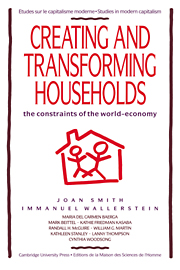Book contents
- Frontmatter
- Contents
- Preface
- I INTRODUCTION
- II THE UNITED STATES
- Introduction
- 1 The Detroit story: the crucible of Fordism
- 2 New York City: the underside of the world's capital
- 3 Binghamton: the secrets of a backwater
- 4 Puerto Rico: from colony to colony
- III MEXICO
- IV SOUTHERN AFRICA
- V CONCLUSION
- A postscript on method
- References
- Index
- Studies in Modern Capitalism
3 - Binghamton: the secrets of a backwater
Published online by Cambridge University Press: 07 June 2010
- Frontmatter
- Contents
- Preface
- I INTRODUCTION
- II THE UNITED STATES
- Introduction
- 1 The Detroit story: the crucible of Fordism
- 2 New York City: the underside of the world's capital
- 3 Binghamton: the secrets of a backwater
- 4 Puerto Rico: from colony to colony
- III MEXICO
- IV SOUTHERN AFRICA
- V CONCLUSION
- A postscript on method
- References
- Index
- Studies in Modern Capitalism
Summary
The great economic engines that powered the growth of the United States as a core zone lay in the major metropolitan centers, such as Detroit and New York. But the process involved in this growth also worked themselves out in hundreds of smaller manufacturing cities around the nation. Broome County, New York, had established itself as such a secondary center by 1880.
Broome County is located in southern New York along its border with Pennsylvania and is the smallest urban county in the state. The major city in the county, Binghamton, grew as a manufacturing center in the late nineteenth century. Around the turn of the century two new towns, Johnson City and Endicott, were founded around shoe factories. These three communities have formed a single urban area, which in 1940 had a population of about 150,000, and in 1980 of approximately a quarter of a million people.
Through most of the period from 1890 to 1960, Broome County was a one-industry center. The organization and concentration of labor first in the cigar industry and then in shoe manufacturing dominated capital–labor relations in the area. It is therefore useful to divide the labor force history of the area into three periods: (1) cigars, 1880–1910, (2) shoe manufacturing, 1910-60, and (3) diversified manufacturing, 1960–80. In all periods, the overall average wage for Broome County was less than the overall average wage for the US as a whole.
- Type
- Chapter
- Information
- Creating and Transforming HouseholdsThe Constraints of the World-Economy, pp. 91 - 120Publisher: Cambridge University PressPrint publication year: 1992



